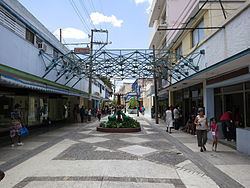Country | Elevation 55 m Area 918 km2 | |
 | ||
Map of Bayamo
Bayamo is the capital city of the Granma Province of Cuba and one of the largest cities in the Oriente region.
Contents
- Map of Bayamo
- Bayamon puerto rico
- Air view of bayamo cuba 2016 4 k video
- Overview
- History
- Demographics
- Transportation
- Notable residents
- References

Bayamon puerto rico
Air view of bayamo cuba 2016 4 k video
Overview
The community of Bayamo lies on a plain by the Bayamo River. It is affected by the violent Bayamo wind.
One of the most important education institutions in the province is the University of Granma.
History
Bayamo was the second of the seven cities founded by Diego Velázquez de Cuéllar; it was established on November 5, 1513. Francisco Iznaga, a Basque landowner in the western portion of Cuba during the first 30 years of the colonization of Cuba, was elected mayor in 1540. Iznaga was the originator of a powerful lineage that finally settled in Trinidad, where the Torre Iznaga (Iznaga Tower) is. His descendants fought for the independence of Cuba and for annexation to the U.S., from 1820 to 1900.
During much of the 16th century it was one of the most important agricultural and commercial settlements of the island. Its inland situation gave it relative security against the pirates who infested West Indian seas, and the misfortunes of Santiago were the fortunes of Bayamo. Down the Cauto River, then open to the sea for vessels of 200 tons, and through Manzanillo, Bayamo drove a thriving contraband trade that made it the leading town of Cuba at the opening of the 17th century.
A tremendous flood, in 1616, choked the Cauto with trees and wrecked vessels, cutting it off from direct access to the sea; but through Manzanillo it continued a great clandestine traffic with Curaçao, Jamaica, and other foreign islands throughout the 17th and 18th centuries. Bayamo was then surrounded by fine plantations.
In 1827 it acquired the status of city. In the war of 1868–1878 it was an insurgent stronghold. One of the most desperate conflicts of the war was fought nearby, and it was nearly destroyed by the opposing parties.
Demographics
In 2004, the municipality of Bayamo had a population of 222,118. With a total area of 918 km2 (354 sq mi), it has a population density of 242.0/km2 (627/sq mi).
Transportation
Bayamo is an under-recognized world leader in sustainable transportation. Per a UN study only about 15% of commuters rely on motorized transport and almost three times as many (39%) rely on about 500 licensed horse-drawn carriages generally following fixed routes. The rest of the non-pedestrian traffic is bicycle and bicycle taxi.
